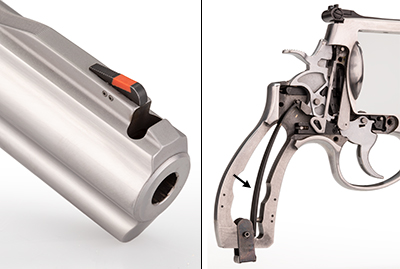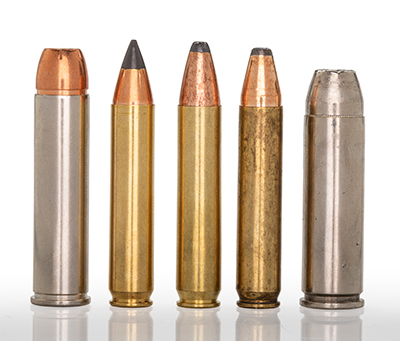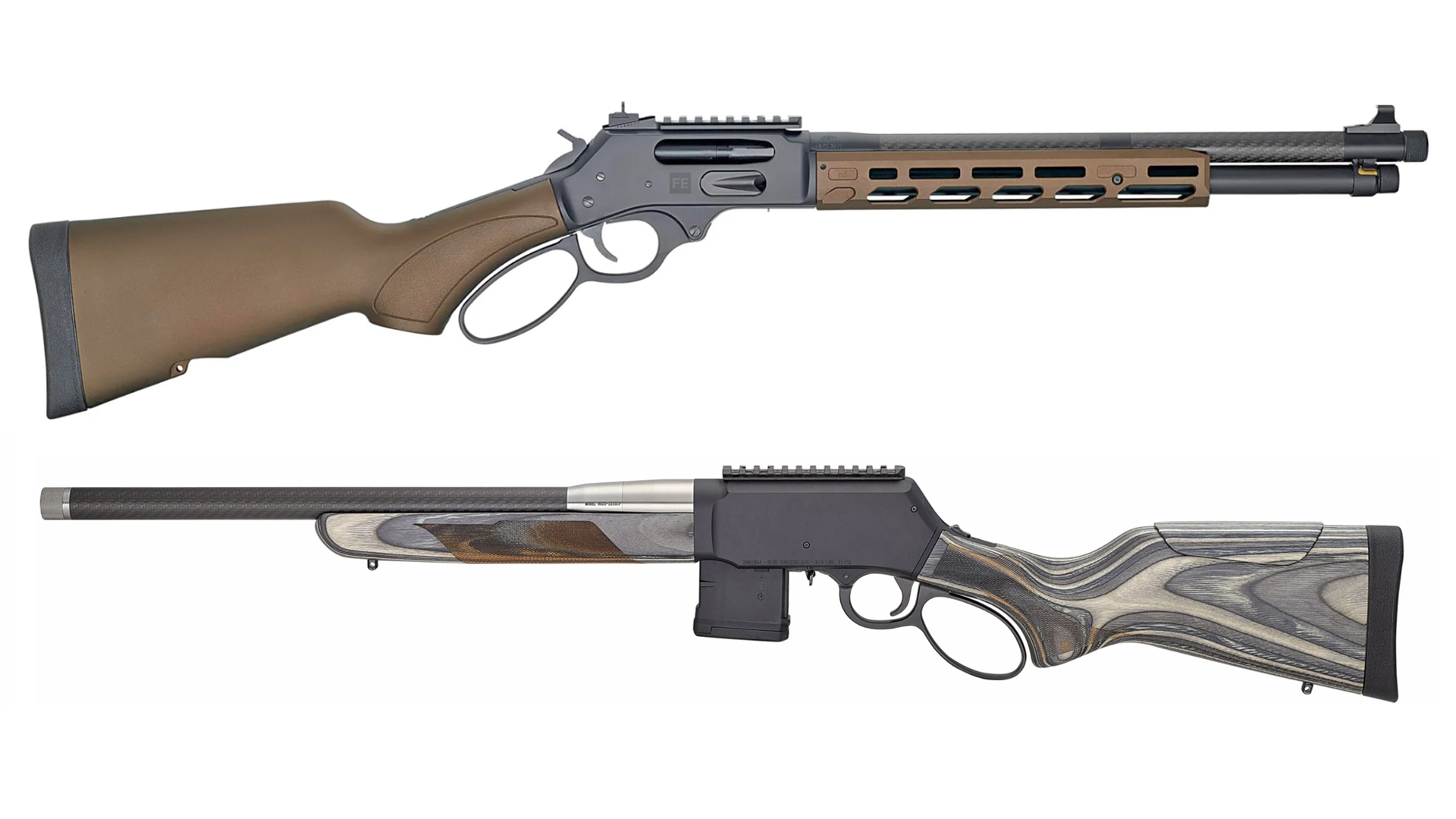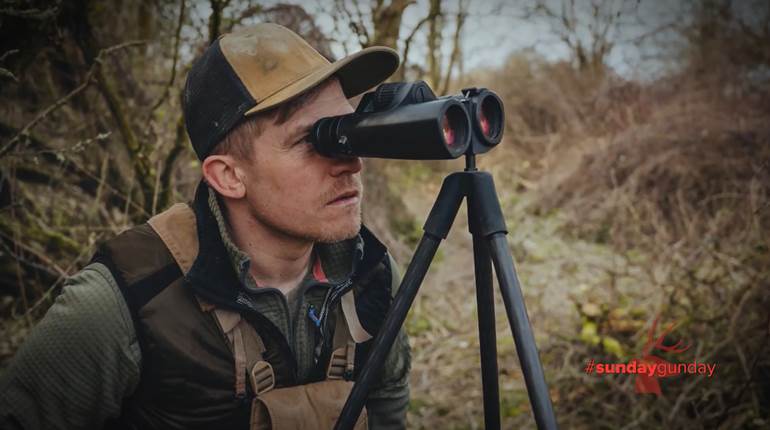
Until just recently, Smith & Wesson had only ever chambered its mammoth X-Frame revolvers to fire two cartridges of its own design. Both of these were expressly devised from the outset to be record-breakers intended to assert the company’s dominance over the rest of the wheelgun market and secure its place in the record books—perhaps permanently—as the maker of both the most powerful (.500 S&W Mag.) and fastest (.460 S&W Mag.) production revolver cartridges in the world. Given the grandiosity of that opening act, Smith’s rationale behind adding the Model 350, chambered in 350 Legend, to the X-Frame line last year seems downright mundane by comparison: It’s just a well-designed, easy-to-shoot cartridge that very effectively fulfills the role for which it was intended—short-range deer hunting. How uncharacteristically sensible for a fantastical platform that literally owes its very existence to an exaggeration famously uttered by a fictional dirty cop about his hilariously impractical choice of sidearm.
And yet sometimes the truth really is stranger than fiction. In 1971, when Dirty Harry declared his .44 Mag.-chambered Model 29 to be “the most powerful handgun in the world”—as factually inaccurate as that statement was even 52 years ago—it created a very real-world mythos surrounding the Smith & Wesson big-bore revolver that the company took off and ran with. So enamored was S&W with this association of its brand with incredibly powerful revolvers that it decided steps were necessary to cement the company’s status as king of the revolver hill in reality as well as in cinematic lore. In the early aughts, Herb Belin (handgun product manager for the company at the time) and his team of engineers collaborated with Peter Pi of Cor-Bon Ammunition to create first the .500 and then the .460 cartridges—along with the necessarily colossal wheelguns sturdy enough to safely fire them. The rest, as they say, is history.
Which brings us to last year when an unlikely sibling was added to the family. At first blush, the Model 350 seems to fit right in with the rest of the X-Frame roster—and its internals are, in fact, pretty much identical to the models that have come before it. But the newest member of the family does depart from its big-bore brethren in a number of ways, and most of them come down to just how different the 350 Legend cartridge is compared to S&W’s .500 and .460 magnums.
Apart from being the first X-Frame chambering that the company didn’t have a hand in developing, because 350 Legend is a re-purposed rifle cartridge and wasn’t designed from the ground up for revolver use, it’s also the first one with a rimless case. And, as the first medium-bore, it likewise offers a greater, seven-round capacity than either the Model 500 or 460XVR, which are both five-shooters. In fact, the longer you sit down and compare and contrast the three, the more it becomes a case of “One of these things is not like the others, one of these things doesn’t belong”—but in a good, much more practical and accessible way.

For a long time, the working title of this article was “The Sane Man’s X-Frame,” and while my tongue was firmly planted within my cheek when I wrote that, there’s more than a little bit of truth to it. Calling the harsh-kicking .500 and .460 magnums “wrist-breakers” may be slight hyperbole, but for all but the most experienced of hand-cannon shooters, calling them “flinch-makers” is not. I’m not saying that you have to be a masochist to truly enjoy shooting these two through a handgun—but it sure helps. On the other hand, I think the majority of shooters will find firing the much more controllable 350 Legend-chambered X-Frame to be a pleasant experience—and that may very well be the first time that the terms “X-Frame” and “pleasant” have ever appeared in the same sentence.
Exceedingly rare is the new cartridge introduction that becomes an immediate success. Heck, even 6.5 mm Creedmoor—the landslide winner of the most impactful new chambering in a long while—took an entire decade to reach full steam. Which elevates the 350 Legend up into some pretty rarified air—air that, more often than not, involves military adoption. In our initial story on Winchester’s new design, I forecast that the straight-wall rifle cartridge had enough going for it that it would eventually secure the support—from the industry and shooters alike—to become a mainstay, and not just a flash in the pan like most introductions. In my mind, I was thinking it would take maybe a decade to find sure footing on the market; by most accounts, it had done so by the following deer season.

For confirmation, I reached out to my contacts at Federal, Hornady and Winchester, and the reports back from all three companies were similar. Three years in, 350 Legend has already solidified itself as one of the most popular cartridges within those states that mandate straight-wall cartridge designs for rifle hunting, and although interest outside of those areas has been more limited, it sells elsewhere nonetheless as well. As a result of this uncommon success, the Model 350 will be leaps and bounds easier (and more economical) to keep fed than its big-bore stablemates. The cartridge has already been picked up by several outdoor chains and big-box stores as a standard item—and more than one load of inexpensive practice FMJs is already on the market, unlike either of Smith’s home-grown magnums.
While S&W has added big-bore X-Frames in a wide variety of flavors to its catalog during the past 15 years—from 3.5"-barreled last-ditch bear-defense snubbies to 14"-barreled behemoths weighing more than some carbines—only one Model 350 SKU is available at launch. A 7.25"-barreled gun, it weighs 71.5 ozs. (4 lbs., 7.5 ozs.) empty, corresponding pretty closely both length- and girth-wise with the original versions of the 500 and the 460XVR, which each debuted with 8 3⁄8" barrels and tipped the scales at 76 ozs. and 72.5 ozs., respectively.

A formidable hunk of metal, the 350 stands a commanding 13¾" long and 6¼" tall. Its cylinder, yoke, barrel sleeve and barrel shroud are all made from 410 stainless steel, while the frame itself is 416 stainless. The company calls the finish on these parts “satin,” but it appears a bit glossier than that to my eye. Like the rest of the X-Frames, and indeed most modern S&W wheelguns, the Model 350 is a double-action/single-action revolver with a hammer powered by a flat mainspring—and the cylinder advances in a counterclockwise direction when either the trigger is pulled or the hammer is cocked back manually.
If the decision to make a 350 Legend-chambered double-action revolver was largely an admission to the viability of its cartridge, the decision to make it an X-Frame specifically was primarily out of sheer necessity. The 1.75" cylinder of S&W’s N-frame revolvers just wasn’t long enough to accommodate the 2.260" maximum cartridge length of the golf pencil-shaped rifle cartridges, while the cylinder of the Governor and its Z-frame was unnecessarily lengthy. But situated there in the middle, like the proverbial baby bear’s porridge, was the X-Frame’s 2.3"-long cylinder.
Due to their immensely powerful chamberings, several additional safety features were built into the .500 and .460 X-Frames. While they aren’t quite as necessary in a 350 Legend-chambered gun (which generates about half the muzzle energy of the others while operating at a much lower pressure), they were nonetheless also incorporated into the Model 350, as a manufacturing expedient if nothing else. And an increased safety margin is never a bad thing.

First among these is an integral lug in the frame that provides supplementary support to the 350’s fluted cylinder from the front, in addition to the standard revolver practice of locking at the breechface. This lug nests within a corresponding cutout in the yoke. Under recoil, a spring-loaded plunger within the lug is forced even more firmly against its locking recess, resulting in an action that is locked up tighter when the gun is being fired than when it is not.
The Model 350 also continues the X-Frame tradition of having an odd number of chambers, and while that may seem like trivial happenstance, it is actually a very clever decision on the engineers’ part. In a standard six-shooter, the cylinder’s stop notches are located directly over a chamber; by designing the X-Frame to chamber first five, and now seven, rounds, it allows the notches to be positioned between the chambers, where the cylinder’s steel is the thickest. To further bolster the 350’s strength, both its frame and cylinder undergo a heat-treating process.
Despite the rimless nature of the cartridge, 350 Legend rounds can be chambered and fired in the Model 350 without the need for moon clips, thanks to counter-bored chambers that abut the case mouths to facilitate proper headspacing. However, Smith does include a pair of full moon clips that allow all seven chambers to be loaded or unloaded simultaneously. While not mandatory, the moon clips are so useful that they might as well be. Shooters who forgo their use can expect to carry a wooden dowel with them to the range, as without the clips, the gun’s star extractor has no rim to contact, and a tool will be needed to push each empty case out individually.
The Model 350’s internals are secured within its frame beneath a right-side, three-screw sideplate. Opposite it on the left side of the gun is a checkered “S&W-style” cylinder release that is actuated by a right-handed shooter pressing forward with his or her shooting-hand thumb. Directly above that control is the key slot for the internal hammer-locking mechanism that has been present on all of the company’s revolvers for the past two decades; two keys are included.
When Smith up-sized everything to make the X-Frame, it had the foresight to not include the grip frame in this enlargement, as the resulting proportionally sized grip would have been unworkable by all but the most shovel-handed of shooters. Instead, the X-Frame borrows the mid-size grip frame of S&W’s K-frame revolvers, and the Model 350 is no different. The included overmolded-rubber Hogue Monogrip, with molded-in finger grooves and texturing and a slight palm swell, completely encloses the grip frame and makes for a very comfortable shooting experience, as it very effectively provides both solid purchase and cushioning against the recoil of the handgun.
An exemplarily crisp trigger will generally feel as if it is breaking at a lighter pull weight than it actually is, and I found that to be the case with the single-action mode of the Model 350’s sharply curved, smooth-faced trigger. For 10 pulls, the mean release came at 5 lbs., 1 oz., of pressure when manually thumbing the checkered hammer spur back—but the clean break, lack of take-up and minimal overtravel made it feel about a pound or so lighter than that. On the other hand, the revolver’s double-action pull was smooth and remarkably consistent, if relatively heavy; the average of 10 pulls came to 12 lbs. even, with all results falling between 11 lbs., 10 ozs., and 12 lbs., 2 ozs., after about 1/8" of take-up prior to engagement.

Although S&W advertises the Model 350 as having a 7½" barrel, from the start of the forcing cone to the tip of the muzzle, my test sample’s barrel measured right at 7¼". The barrel’s shroud is keyed into the frame by a steel tab located at 6 o’clock, and its full-underlug design completely encloses the knurled, spring-loaded extractor rod, protecting against inadvertent damage. A series of 10 longitudinal grooves has been cut into the top of the shroud to help reduce glare, and the topstrap of the frame has been given a much less reflective finish than the rest of the gun for the same reason. About 1/2" from the muzzle, just forward of the front sight, a single port has been cut into the top of the barrel to direct ignition gases upward and force the recoiling barrel back downward, and it certainly seems to help contribute to the controllability of the gun.
For sights, the 350 is coming from the factory with a fully adjustable U-notch rear and a fixed ramp front with a red insert. This sight picture is useful enough for those who just want to run the irons, but, in my experience, most handgun hunting takes place with the assistance of an optic, and I was disappointed to learn that Smith is not currently offering a scope-mounting kit compatible with the Model 350. Fortunately, the Weig-A-Tinny Weaver/Picatinny mount from Weigand Machine and Design (jackweigand.com, $60) fits the new revolver perfectly, without any permanent alterations to the gun (just the removal of the rear-sight assembly), and a quick email to Jack got a mount headed inbound for my use during the below range work.
But before we get there, we first need to address something that I’m sure more than a few of you are curious about: As a .35-cal. revolver, can the 350 Legend X-Frame also chamber and fire .357 Mag./.38 Spl. cartridges or maybe even 9 mm Luger with the assistance of the included moon clips? The answer is, unfortunately, no. The 9 mm is right out—due to a wider case head, 9 mm Luger rounds don’t work with the seven-round moon clips, or headspace properly without them—but .357/.38 cases, will, in fact, chamber in the Model 350, and its cylinder will close on them. However, S&W explicitly warns against this practice, probably due to most .357 Mag. projectiles unsurprisingly measuring 0.357" in diameter while 350 Legend bullets are actually 0.355", and shooters are taking their safety into their own hands if they give this a try.
Previous testing showed that, through a 16"-barreled carbine, most 350 Legend loads generate approximately 1,650 ft.-lbs. of energy at the muzzle. But, as is the case when any cartridge designed around a rifle-length barrel is chopped down to handgun length, a portion of the 350 Legend’s ballistic potential is wasted in the Model 350—as was evidenced by the impressive fireball that results from each pull of the trigger—but it was a smaller percentage than I initially feared.
Over an Oehler 36 chronograph, my three test loads—Federal 180-grain Power-Shok, Hornady 170-grain American Whitetail and Winchester 150-grain Deer Season XP—maintained about 1,000 ft.-lbs. of energy at 15 feet through the shortened barrel. While not in the same class as its X-Frame relatives, the Model 350 still generates roughly 25 percent more muzzle energy than a .44 Mag. revolver (one of the most popular options for handgun hunting) of comparable barrel length—so there can be no doubt as to the 350’s potency on deer-size game at any responsible pistol-hunting distance.
The .44 Mag. also provides us with a useful reference to discuss just how controllable the Model 350 is. In guns of identical weight, most 350 Legend loads do produce slightly more recoil velocity and energy than the average .44 Mag. load, however, the heaviest .44 on S&W’s website comes in at “only” 59.4 ozs., so this is misleading. I’ll spare you all the math, but using my personal 55-oz. Model 629 Stealth Hunter as an example, despite all the 350 Legend’s extra muzzle energy, recoil levels through the Model 350 were nearly identical to those of the .44 Mag.—with lighter .44 loads generating less and any bullet weighing 225 grains or greater generating more. Now, I understand that saying “It has only .44 Mag.-level recoil” might not make the Model 350 sound all that impressively shootable, but remember how big of a .44 we’re talking about here. Trust me that this thing is a far cry more fun to shoot than even the largest .500 or .460 X-Frame—enough so that the idea of off-season practice won’t make you cringe.
Upon my first trip to the range with the wheelgun, it took exactly two shots to determine that my test sample had timing issues: The first blast to the face got me 99 percent of the way there and a second one confirmed it. The revolver was shipped back to the company for repairs, and three weeks—and a new barrel and yoke—later, I returned to the range to have another go at it. This time, it was smooth sailing. Accuracy-wise, the 350 performed quite well. Using a Leupold FX-II 4X 28 mm handgun scope atop the Weigand mount, it turned in five-shot groups at 50 yards that averaged 1.48". Given the fairly generous size of a deer’s vital zone, these results, in the hands of a competent revolver hunter, are more than adequate to get the job done and the freezer packed.
While they are awesomely powerful hunting tools, the intimidating recoil and hen’s-tooth ammunition availability of Smith & Wesson’s .500 S&W Mag. and .460 S&W Mag. X-Frames essentially relegates their use to a small cadre of die-hard (and well-heeled) handgun hunters and hand-cannon aficionados—and even most of those guys don’t shoot them all that often. Which really effectively illustrates the opportunity that the Model 350 represents as the perfect handgun-hunting gateway gun.
In contrast, the new gun might not push the bounds of revolver design in the same way that the larger-caliber X-Frames did, but, by offering much more tolerable recoil and ammunition that is both plentiful and inexpensive enough that regular practice is feasible, neophytes should find it to be a much less daunting, yet still highly capable, entry into this esoteric and highly challenging field. And between that added accessibility and the already-solid and still-growing interest in the 350 Legend cartridge, I would not be at all surprised if one day soon sightings of the Model 350 in the wild start to outnumber those of its big-bore brethren.
















![Auto[47]](/media/121jogez/auto-47.jpg?anchor=center&mode=crop&width=770&height=430&rnd=134090788010670000&quality=60)




















